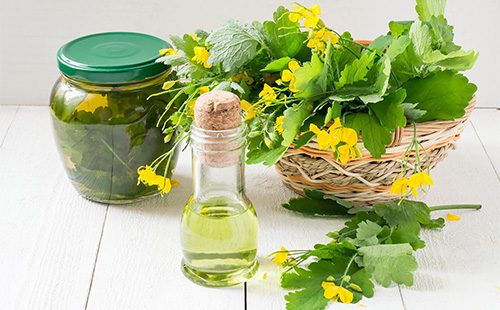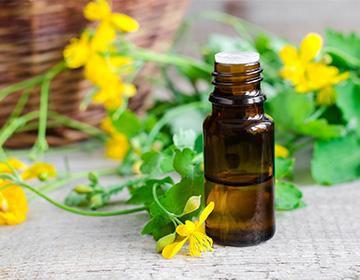The content of the article
This is a product of industrial production. In addition to the oil base, the composition includes warthog extract, antioxidant and mineral complexes. The drug is considered cosmetic and is not used as a medicine. The reason for this is the low content of active alkaloids of the grass and the absence of the status of pharmacopoeial plant material in celandine. However, the instructions for the tool indicate a lot of indications for its use. Most of them are marketing ploys, although fat extract can still bring some benefit.
Home Manufacturing Technology
This plant is a frequent guest of summer cottages, grows near fences and along the walls of houses. He needs partial shade. With moderate humidity, grows up to 1 m in height and blooms actively all summer. During flowering, stocks of medicinal raw materials should be made.
- Collection. Collect grass should be in May-June. During this period, the plant contains the largest amount of valuable substances. Cut off the flowering aerial part, departing from the soil by 10-20 cm.
- Training. Harvested are the leaves, flowers and stems of the plant. Sort the collected grass for damaged, discolored and lignified parts - they are removed.
- Drying. Raw materials are laid out loose on a pallet or hung on ropes in a shaded, well-ventilated place. In the drying process, they are often turned over. When using dryers adhere to temperature conditions up to 40ºС.
Dried raw materials are crushed, packaged in glass or cardboard containers, stored for two years.
Recipe
Features To prepare the product, it is better to use freshly dried celandine. As an extractant, vegetable oil is used. For cosmetic purposes, olive, peach, almond are suitable. But you can use unrefined sunflower.
Cooking
- The glass container is filled with crushed grass to 2/3 of the volume.
- Pour the raw material with oil so that its layer is 2 cm higher than the grass.
- Close the container tightly, shake the mixture, leave for a day in a warm place.
- Then move the container to a dark, cool place and stand for another week. Shake daily.
- Filter the extract through a double layer of gauze into a storage container. Carefully squeeze the grass.
- Store in the refrigerator. As necessary, use externally.
Manufacturer promises
According to the descriptions of cosmetics sold in a pharmacy, this is a storehouse of alkaloids and vitamins. The claimed list of healing qualities of the product is as follows.
- Acts as an antioxidant. The extract contains natural antioxidants - vitamins C, E, A, which protect the skin from the action of free radicals, prevent earlier aging. Grass does contain vitamins, but their form is unstable, especially in the composition of the oil.A product can possess antioxidant activity only if these organic compounds were artificially introduced into it in chemically stable forms.
- Evens skin color. The manufacturer indicates that the tool helps to remove freckles, age spots, brightens the skin. In fact, the concentration of alkaloids in its composition is too low to exert a keratolytic effect and exfoliate the upper layer of the epidermis.
- Cleans. Among the indications for using the product are excessive oily skin, rashes, and contaminated pores. But any fatty extract, including celandine, cleanses the skin only on the condition that it is used in a hydrophilic form and washed off with foaming compounds. In conventional application, the agent, on the contrary, creates a lipid film (often on top of contaminants) and an optimal environment for the reproduction of microbes. The result of such procedures will be black spots and inflamed acne, even more oily skin.
- Moisturizes. The product, thanks to its fatty acid content, really moisturizes the skin. This occurs as a result of the formation of a film on the surface that protects against moisture loss. However, a systematic violation of cellular respiration leads to a violation of the hydro-lipid balance of the skin and its drying out. The result is peeling, sagging.
- Heals diseases. Manufacturers note the healing, antiseptic, anti-inflammatory properties of the product, as well as the ability to treat skin ailments. It is recommended for almost all epidermal injuries: from psoriasis to burns. In fact, the effect is too weak. The oil does not have a bactericidal effect. And healing is stimulated by the short-term retention of moisture in tissues and protection from external influences.

The real beneficial properties of the product
However, some useful properties of the product are inherent.
- Relieves inflammation. An extract can lubricate irritated, overdried, inflamed areas of the skin without visible damage. Its use is appropriate for mild thermal and sunburn, itching, provoked by dryness.
- It softens the skin. Can be applied to dry skin with signs of hyperkeratosis. The agent is not able to significantly reduce keratinization of the epithelium, but it is within its power to soften and facilitate the separation of already formed scales. The same situation with corns and corns - oil will not remove them, but will soften the surface layer, after which it is easier to scrape off.
- Strengthens hair. The product is rubbed into the scalp to improve hair condition and eliminate dryness. The tool is used in courses. But here it is important to understand: strengthening of hair follicles and strengthening of their supply of useful substances occurs mainly due to the activation of blood circulation during massage during application of the product.
The tool is advisable to use only for short courses, locally applying to dry and itchy places, corns. The exposure time should be limited - no longer than an hour. After the procedures, the oil should be thoroughly washed off.

